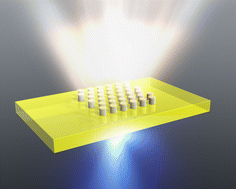Nanowerk December 21, 2022
Phosphor plates combined with nanoantenna, enable spatial and spectral control over luminescence. While the emission enhancement in a specific direction has been reported in nanoantenna studies, the evaluation of the total distribution of radiation as well as the conversion efficiency is largely missing. An international team of researchers (Japan, China) developed nanoantenna phosphors consist of a hexagonal array of titanium dioxide (TiO2) nanoparticles, fabricated on a phosphor plate of yttrium aluminum garnet doped with Ce3+ (YAG:Ce). They visualized the distribution of photoluminescence from the nanoantenna phosphor into forward, backward, and side directions by using an integrating sphere. Their experimental results clarified that the nanoantenna increases the forward emission and decreases the side emission, while the total emission intensity remains unchanged. They enhanced the forward emission by depositing the Bragg reflector on the bottom of the plate. A simple analytical model explained the effects of the antenna size, the plate thickness, and the Bragg reflector on the distribution of radiation. According to the researchers the new nanoantenna phosphors are advantageous for intensely bright yet energy-saving solid-state lighting because they can suppress temperature rise when irradiated…read more. TECHNICAL ARTICLE

…The antenna redistributes the spatial radiation pattern while the total emission intensity remains unchanged. Credit: J. Mater. Chem. C, 2023, Advance Article, December 21, 2022